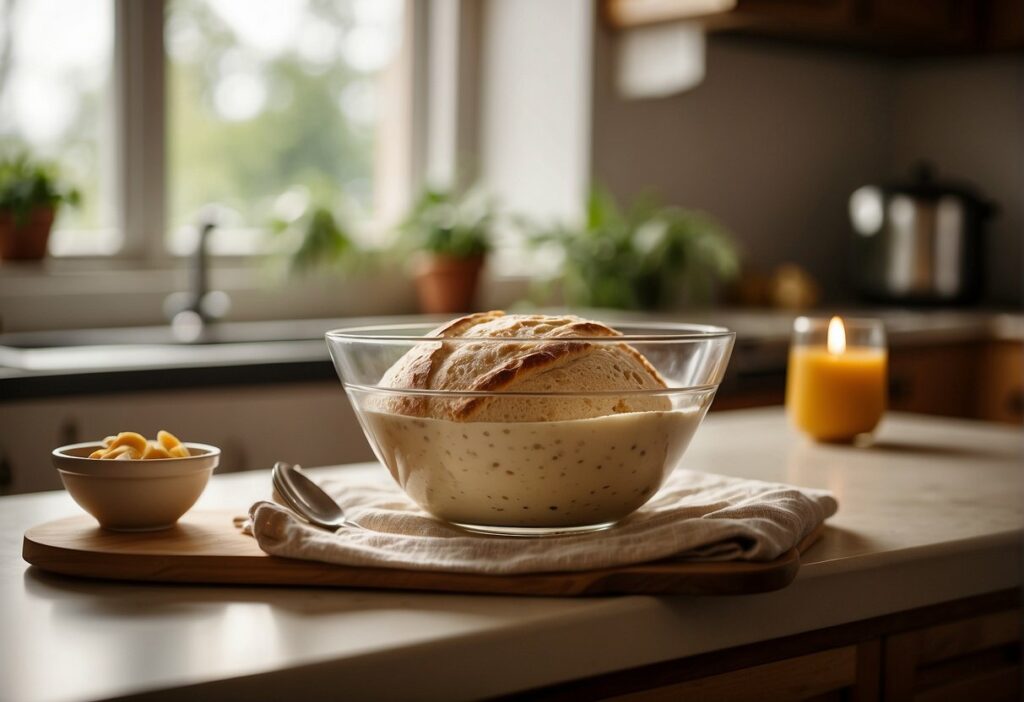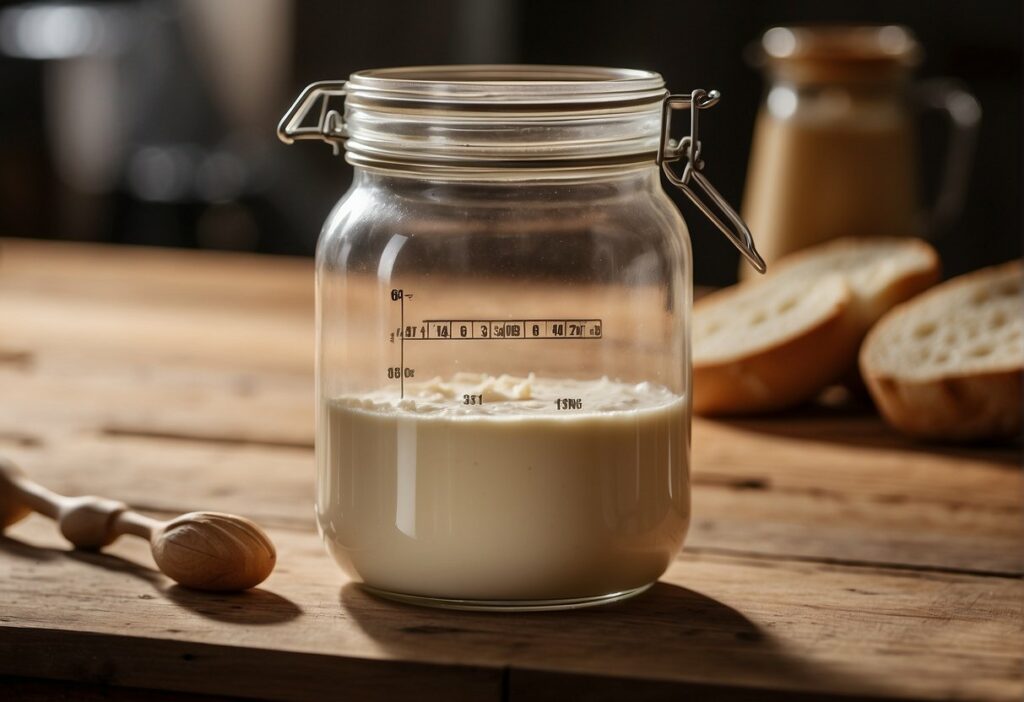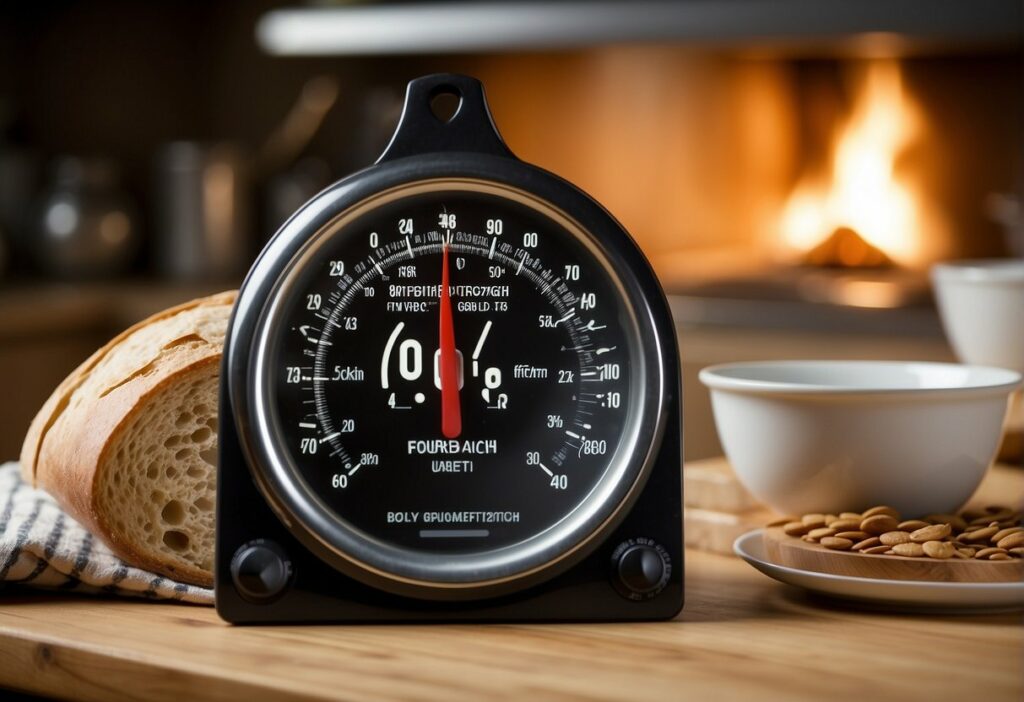Bulk fermentation is a critical stage in the sourdough bread-making process, where the dough is allowed to rise before being shaped and baked. This step plays a significant role in developing the bread’s flavor, texture, and structure. Achieving optimal results during bulk fermentation largely depends on maintaining the right temperature, as it directly influences the activity of yeast and beneficial bacteria in the dough.

Maintaining a temperature between 70°F to 80°F (21°C to 27°C) is typically recommended during this phase. Warmer temperatures usually accelerate fermentation, contributing to a more active dough with a robust flavor profile. However, it’s crucial to consider that exact temperature may vary depending on individual sourdough starters and desired outcomes.
Key Takeaways
- The temperature during bulk fermentation affects sourdough bread’s flavor and texture.
- A range of 70°F to 80°F is generally ideal for promoting yeast and bacterial activity.
- Specific temperature needs may vary based on sourdough starter characteristics and the baker’s goals.
Understanding Bulk Fermentation
Bulk fermentation, the critical phase in sourdough bread making, profoundly influences the flavor and texture as it allows yeasts and bacteria in the starter to produce carbon dioxide and organic acids.
The Role of Temperature in Sourdough Fermentation
Temperature acts as a throttle for the activity of yeast and bacteria in sourdough. Optimal temperatures encourage a balance of yeast action and bacterial development, which contribute to the dough’s rise and flavor profile. Consistent dough temperature ensures even fermentation.
- Warm temperatures (above 70°F/21°C): Accelerate yeast activity, leading to a quicker rise.
- Cool temperatures (below 70°F/21°C): Slow down fermentation, enhancing flavor complexity.
Optimal Conditions for Sourdough Bulk Fermentation
The desired temperature range for bulk fermentation is generally between 70°F to 80°F (21°C to 27°C). This range fosters an environment conducive to a healthy and active sourdough culture, allowing the dough to develop strength and the gluten network to stabilize, contributing to the bread’s final structure.
- Aim for 74-76°F (23-24°C) for most balanced fermentation.
- Maintain ambient temperature or use a dough container equipped to regulate temperature.
Impact of Temperature Variations on Sourdough Fermentation
Temperature fluctuations can lead to inconsistent fermentation, often resulting in bread with poor texture or flavor. Dough that ferments at too high a temperature might:
- Become over-proofed: yeasts exhaust their food supply too quickly, weakening the dough structure.
- Loss of subtle flavors: overshadowed by the excessive production of acid.
Conversely, dough that ferments at too low a temperature may:
- Be under-proofed: insufficient gas production, leading to dense bread.
- Take excessively long to double in volume, which might be impractical.
Identifying Fermentation Stages and Visual Cues
Recognizing when the dough has properly fermented involves visual and tactile assessments. During bulk fermentation, look for:
- Dough size: typically, it should double in volume.
- Texture changes: it should become puffy with a slight sheen.
- The poke test: the dough should hold the indentation briefly before slowly springing back.
Managing Dough Hydration and Temperature
Hydration of the dough plays a significant role in fermentation. A higher hydration level can:
- Accelerate fermentation: more water for yeast and bacteria to move and metabolize.
- Contribute to open crumb structure: more water creates more steam and lift during baking.
It’s critical to adjust hydration based on ambient temperature:
- In warmer conditions, reduce hydration to slow fermentation.
- In cooler conditions, increase hydration to compensate for slowed yeast activity.
To maintain precise dough temperature:
- Use a Cambro or similar container designed to keep a consistent temperature.
- Monitor the dough and adjust the environment as needed.
Understanding and controlling the temperature of bulk fermentation ensures the development of flavor and texture that distinguishes superior sourdough bread.
Best Practices for Sourdough Bulk Fermentation
In sourdough baking, the bulk fermentation stage is crucial for flavor development and structural integrity of the loaf. Mastering this phase is essential for achieving quality sourdough bread.
Techniques for Consistent Fermentation
A baker must maintain precise control over the fermentation process to ensure a consistent quality in their sourdough loaves. Ambient temperature directly influences fermentation time; therefore, regulating this factor is key. For most sourdough recipes, maintaining a dough temperature of approximately 74-76°F (23-24°C) during bulk fermentation is beneficial for gluten development and microbial activity. Implementing techniques such as stretch and folds—periodic stretches and folds of the dough throughout fermentation—helps to evenly distribute temperature, yeast, bacteria, and sugars, which are crucial for a uniform rise.
Tips for Preventing Over and Under-Fermentation
To prevent over-fermentation, which can weaken gluten structure and result in a dense loaf, one needs to observe the dough and not just the clock. Signs of readiness include the dough nearly doubling in volume and having a domed surface with bubbles. On the other hand, under-proofed bread is often the consequence of insufficient fermentation time, leading to tight crumbs and lack of flavor. Consistently using the same container for fermenting the dough can help bakers become familiar with how their dough should look at various stages, making it easier to prevent both over and under-fermentation.
Selecting the Right Container and Environment
Choosing an appropriate container for bulk fermentation can affect the outcome of sourdough bread. Clear glass or plastic Cambro containers are popular because they allow bakers to monitor the dough’s progress from all sides. These containers should be large enough to allow the dough to expand without constraint during the first rise. Additionally, maintaining the dough in an environment with controlled humidity and ambient temperature helps to achieve a consistent fermentation process and, by extension, a more predictable sourdough loaf.
Incorporating Whole Grains into Your Sourdough
The addition of whole wheat flour to sourdough introduces a richer nutrient profile and a more complex flavor profile, including potentially more pronounced sour flavors. However, whole grains also absorb more water and can speed up fermentation. It’s recommended to adjust hydration levels accordingly and to monitor fermentation time more closely to avoid over-proofing. The knowledge of how whole grains affect the overall quality of the sourdough loaf is essential, and bakers may need to modify their practice, like shaping duration and techniques, to achieve the desired result.
Advanced Sourdough Fermentation Techniques

To elevate sourdough baking, understanding the nuances of fermentation and the role of starters is crucial. These techniques affect dough temperature, flavor development, and texture.
Exploring Pre-Ferments and Levain Use
Creating a pre-ferment or levain primes the dough for a successful first rise. The levain is essentially a portion of sourdough starter that is matured until peak activity. It introduces a robust population of yeasts and bacteria into the dough, initiating strong fermentation. This pre-ferment leads to a pronounced rise and a well-developed gluten matrix.
Achieving the Perfect Sourdough Texture and Flavor
The texture and flavor of sourdough are byproducts of fermentation. Maintaining a controlled dough temperature between 70°F to 80°F (21°C to 27°C) facilitates the activity of yeast and bacteria which consume sugars and release carbon dioxide and organic acids. The result is a characteristic sour flavor and an open crumb. Manipulating the fermentation time can amplify or reduce these qualities.
How to Adapt the Bulk Fermentation Process for Unique Recipes
Each sourdough bread recipe calls for adaptability in the bulk fermentation process. A standard guideline is to ferment at 74°F to 78°F (23°C to 25.5°C), lasting 2 to 5 hours. For recipes requiring subtler flavors or denser textures, the fermentation time can be adjusted, or the dough can be fermented at cooler temperatures to slow down the enzymatic activities.
The Science Behind Yeast and Bacterial Activity in Dough
Yeast fermentation in sourdough operates optimally within a specific temperature range. Yeasts become more active above 70°F (21°C), breaking down starches into sugars, which they consume to create carbon dioxide and alcohol. Concurrently, lactic acid bacteria produce organic acids, contributing to the sourdough’s tangy flavor. The intricate balance between these microorganisms dictates the final quality of the sourdough bread.
Frequently Asked Questions

In managing sourdough bulk fermentation, temperature is a pivotal factor influencing yeast activity and gluten development, determining flavor, texture, and dough structure.
What Temperature Range Is Ideal for Sourdough Bulk Fermentation for Optimal Flavor Development?
The ideal temperature for bulk fermentation ranges from 70°F to 80°F (21°C to 27°C). This range is conducive to the yeast and lactic acid bacteria, promoting balanced flavor and texture.
How does ambient temperature affect the time required for sourdough bulk fermentation?
Ambient temperatures that are higher within the ideal range can accelerate fermentation, reducing the time needed. Conversely, lower ambient temperatures slow down the process, lengthening the fermentation period.
Is there a difference in sourdough quality when bulk fermented at lower compared to higher temperatures?
Lower temperatures during bulk fermentation typically enhance sourdough’s taste through extended fermentation, leading to a more complex flavor profile. At higher temperatures, flavors develop faster but may be less nuanced.
Can you use a proofing box for more consistent sourdough bulk fermentation temperatures, and what setting should it be at?
A proofing box can be used to maintain a consistent temperature for sourdough bulk fermentation. Setting the proofing box to maintain a temperature within the 70°F to 80°F range is advised for optimal results.
How does the temperature of the water used in sourdough affect the overall bulk fermentation process?
The water temperature in sourdough impacts the initial dough temperature. Warmer water can speed up fermentation, while colder water can slow it down, affecting the overall bulk fermentation timeline.
What are the signs of properly bulk-fermented sourdough bread at the correct temperature?
Properly bulk-fermented sourdough should have increased in volume significantly, exhibited a dome-like shape, and presented a web of bubbles when examined. The dough should also feel aerated and slightly puffy.